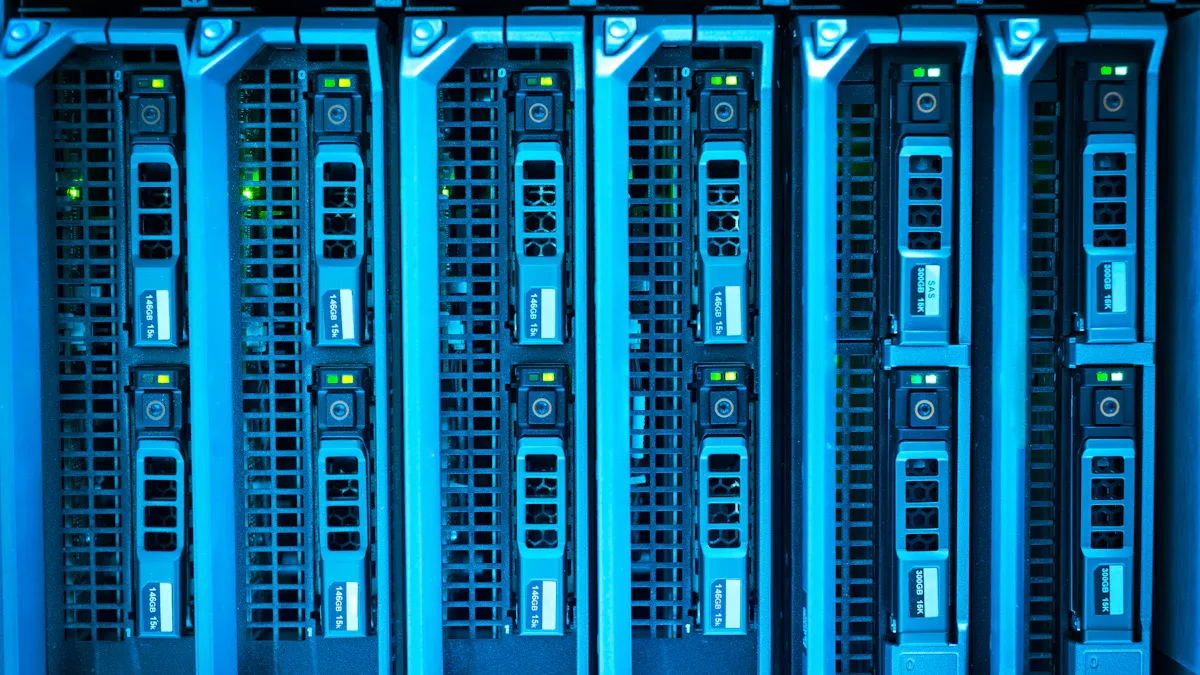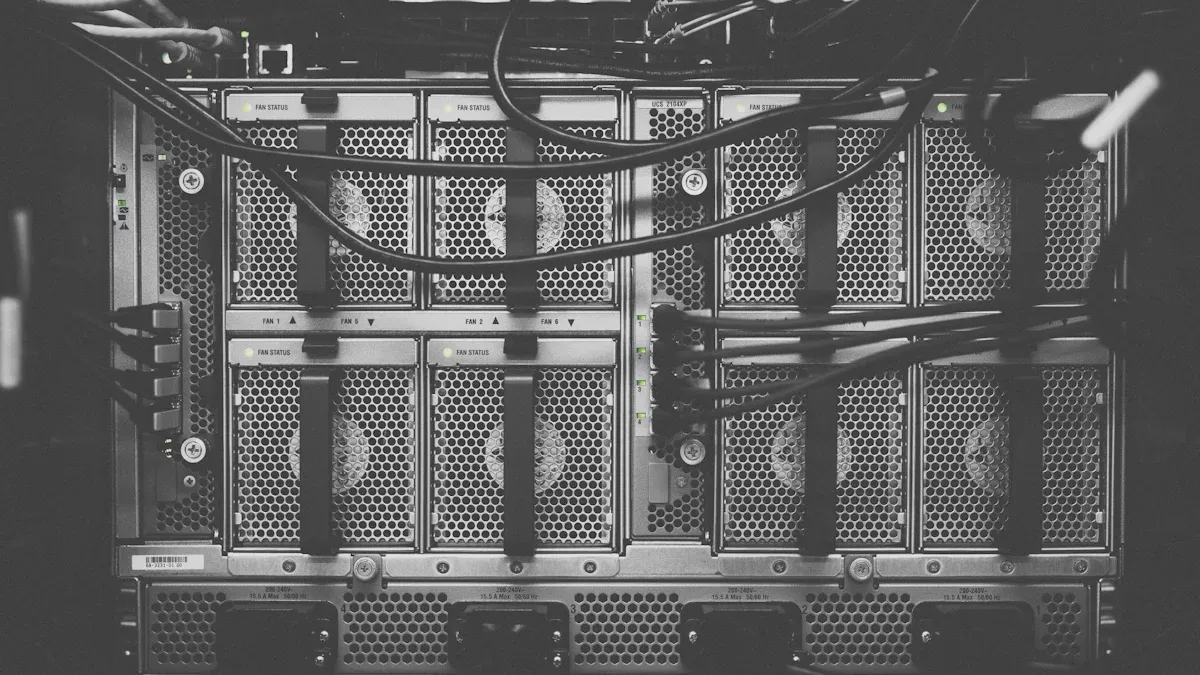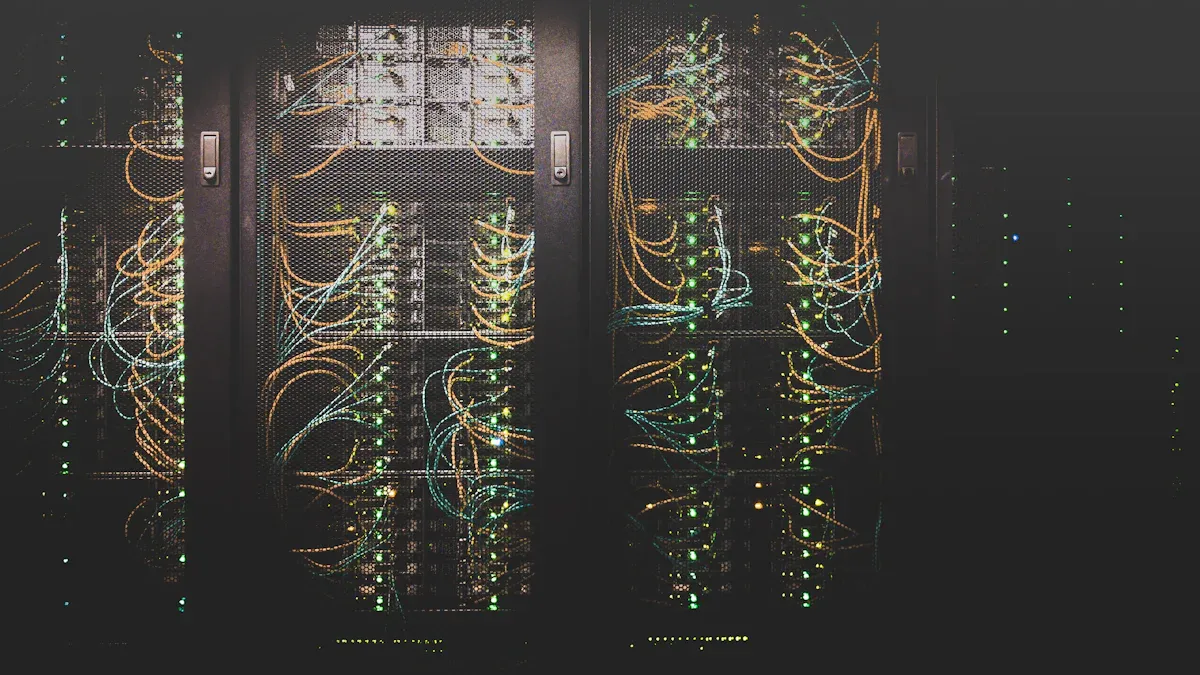
Selecting the right Pdu Switch enhances uptime and reliability in IT racks. Switched PDUs allow remote power cycling, staged power-up, and outlet locking, which reduces downtime and minimizes manual intervention. Brands like Eaton, Tripp Lite, CyberPower, and Server Technology deliver solutions for diverse power and management needs.
Key Takeaways
- Switched PDUs offer remote control and monitoring of power outlets, helping IT teams reduce downtime and improve energy efficiency in data centers and server racks.
- Choosing the right switched PDU depends on factors like power capacity, outlet types, redundancy features, and remote management capabilities to match your specific IT environment needs.
- Top brands provide various features such as automatic power switching, environmental monitoring, and secure access controls, enabling reliable and flexible power management for different rack setups.
Pdu Switch: Top Choices and Ideal Use Cases
Eaton Switched PDUs
Eaton switched PDUs stand out in enterprise IT environments due to their advanced remote monitoring and control features. These units enable real-time tracking of power usage and environmental conditions, which helps IT teams maintain operational efficiency. The robust and durable design withstands demanding conditions, making them suitable for data centers, edge computing sites, and high-density IT setups. Eaton PDUs offer comprehensive safety features, including branch circuit protection and environmental sensors, to safeguard connected equipment. Flexible configurations, such as color-coded outlets and customizable mounting styles, simplify management and installation.
Note: Eaton switched PDUs support scalability and energy efficiency, making them ideal for mission-critical IT infrastructure. Their technology fits environments ranging from small network closets to large-scale data centers, supporting high-density and flexible power distribution needs.
Key advantages include:
- Remote monitoring and control for enhanced operational efficiency
- Durable construction for demanding IT environments
- Comprehensive safety features for device protection
- Customization options for cable length, electrical specifications, and color coding
- Advanced user access control with password protection and SSL encryption
- Hot-swap capability to minimize downtime
Eaton switched PDUs are most frequently recommended for enterprise-level IT environments, including data centers, colocation facilities, and edge computing sites. These environments benefit from features like remote rebooting, power cycling, load shedding, and outlet-level power consumption monitoring.
Tripp Lite Switched PDUs
Tripp Lite switched PDUs distinguish themselves with integrated Automatic Transfer Switch (ATS) functionality, which allows super-fast switchover between primary and secondary power sources. This feature ensures uninterrupted power delivery, even during outages or maintenance. The on-board ATS processor evaluates power quality, preventing transfers to lower-quality sources and supporting redundant power networking applications. Tripp Lite units also provide sequential power-on for outlets, which prevents inrush-related equipment interaction and protects sensitive devices.
| Feature Category | Unique Features of Tripp Lite Switched PDUs with ATS |
|---|---|
| ATS Functionality | Integrated Automatic Transfer Switch for rapid switchover between power sources |
| Power Quality Evaluation | ATS processor avoids transfer to lower quality sources |
| Redundancy Support | Supports redundant power networking and fault-tolerant UPS protection |
| Sequential Power-On | Outlets power on sequentially to prevent inrush current issues |
| Remote Monitoring | Real-time monitoring and outlet power control via secure web/network interface |
| Input Status Indicators | Front input LEDs display power availability |
| Rackmount Design | 1U and 0U rackmount options with flexible mounting and dual input cords for redundancy |
Tripp Lite switched PDUs are commonly used in data centers, hyperscale and colocation facilities, edge data centers, and telecommunications environments. These units provide advanced network control, precise power management, and high reliability, making them suitable for industries that require remote management, energy optimization, and secure power distribution.
CyberPower Switched PDUs
CyberPower switched PDUs deliver advanced remote outlet control, allowing IT administrators to manage individual outlets remotely. Power sequencing features stagger equipment startup, preventing surges and protecting connected devices. Integration with environmental monitoring sensors enables temperature and humidity tracking, which is essential for maintaining optimal rack conditions. Dual power inputs provide redundancy and automatic failover, ensuring continuous operation during power source interruptions. Hot-swappable power modules allow maintenance without downtime, increasing operational flexibility.
For high-density rack environments, CyberPower monitored PDUs offer real-time power monitoring, remote management via SNMP, and scalability with up to 38 outlets in various form factors. These models support both single-phase and three-phase power, making them ideal for data centers with high power loads. Advanced monitoring features help detect power anomalies early, manage power efficiently, and prevent overloads or overheating.
CyberPower switched PDUs are well-suited for small to medium IT environments, such as server rooms and network closets, as well as high-density data centers that require advanced monitoring and management capabilities.
Server Technology Switched PDUs
Server Technology switched PDUs excel in enterprise data centers by providing secure remote monitoring and control at the outlet level. Sequenced power-up minimizes surge currents, protecting connected devices during startup. Load shedding based on specific events optimizes power usage and enhances energy efficiency. These PDUs support high rack power densities, maximizing server count and rack utilization in large-scale deployments.
Administrators can instantly reboot unresponsive equipment remotely, reducing downtime and improving operational flexibility. Automation of power schedules helps balance workloads and reduce energy costs. Integration with environmental monitoring systems offers comprehensive data center management, while flexible configurations meet diverse enterprise needs.
Server Technology switched PDUs are deployed widely in data centers, telecommunications, IT infrastructure, and industrial applications. Their mission-critical reliability, scalability, and adaptability make them a preferred choice for colocation, hyperscale, edge, government, and higher education environments.
What Is a Switched PDU and Why It Matters

Core Functions of a Pdu Switch
A switched PDU serves as a critical component in modern IT racks, offering advanced power management and control. Leading industry standards organizations define several core functions for these devices:
- Remote control of entire PDUs or individual outlets through a secure network interface
- Power cycling of connected equipment to minimize downtime and operational costs
- Staged power-up sequencing to prevent power surges after outages
- Outlet lockout features that enforce security and compliance by restricting unauthorized device connections
- Per-outlet power management, which improves energy efficiency and reduces wasted power
- Real-time monitoring of power usage, temperature, and other critical metrics
- Data logging and analytics for tracking power trends and optimizing energy consumption
- Integration with intelligent monitoring systems and IoT platforms for advanced automation
These features enable IT teams to maintain precise control over rack power distribution, even in large or distributed environments.
Key Benefits for IT Racks
Deploying a Pdu Switch in IT racks delivers significant operational and financial advantages. Remote outlet control allows operators to power on, off, or reboot devices from any location, reducing downtime by approximately 15% compared to traditional metered PDUs. Intelligent monitoring systems provide real-time data, helping teams identify and address energy inefficiencies, which can lead to energy savings of up to 20%.
Remote management capabilities also improve maintenance response times and operational flexibility, especially in virtualized or edge computing environments. By enabling granular power management at the outlet level, switched PDUs help reduce electricity waste and minimize human error. Although the initial investment may be higher, organizations often see a rapid return through lower energy costs and improved uptime.
Comparing Pdu Switch Options: Key Selection Criteria
Form Factor and Rack Compatibility
Switched PDUs come in both horizontal and vertical rack-mount designs. Horizontal models typically occupy 1U or 2U of rack space and fit well in smaller server rooms. Vertical PDUs, often called 0U units, mount along the rack’s side or rear, maximizing space and airflow in high-density environments. This flexibility allows IT teams to select a Pdu Switch that integrates seamlessly with standard 19-inch racks, optimizing both space and cooling.
Power Ratings and Input/Output Options
| Feature | Details |
|---|---|
| Input Voltage Range | 200-250 V (single-phase and three-phase options) |
| Input Current Ratings | Up to 63 A |
| Maximum Power Ratings | Up to 23 kVA |
| Input Connectors | IEC 309, NEMA, region-specific connectors |
| Outlet Types | IEC320-C19 (16 A), IEC320-C13 (10 A) |
| Outlet Quantity | 9 C19 + 3 C13, 12 C13, and more |
| Management Interfaces | Web, Telnet, SNMP, Serial |
These options ensure compatibility with a wide range of equipment and regional standards.
Remote Management Capabilities
IT administrators value remote monitoring and control. Switched PDUs support remote outlet management, environmental monitoring, and real-time alerts. Integration with DCIM systems enables centralized oversight. These features reduce the need for physical visits, improve troubleshooting, and support automation for efficient power management.
Redundancy and Failover Features
- Dual power inputs provide N+1 redundancy, ensuring continuous operation if one source fails.
- Automatic transfer switches enable seamless switching between power sources.
- Remote monitoring and alerts allow quick responses to issues.
- Proper load balancing prevents overloads and supports effective failover.
These features help maintain uptime and operational efficiency.
Security and Access Controls
Modern switched PDUs offer secure remote access through web, SNMP, or CLI interfaces. Multiple access levels, LDAP integration, and user authentication protect critical systems. Environmental sensors and locking power cords add physical and digital security layers.
Deployment and Installation Considerations
- Proper mounting alignment ensures stability and airflow.
- Compatibility checks prevent installation errors.
- Organized cabling improves maintenance and airflow.
- Secure connections and labeling reduce downtime.
- Load balancing and thorough testing verify safe operation.
Careful planning during deployment ensures reliable performance and safety.
Hands-On Insights and Test Results

Real-World Performance
Independent testing highlights the strengths of leading switched PDU brands in demanding IT environments.
- Schneider Electric APC Rack PDUs receive high marks for design and energy efficiency. Their integration with DCIM systems stands out in real-world deployments.
- Eaton ePDU G3 Metered Input delivers billing-grade metering accuracy and robust remote monitoring, making it suitable for enterprise data centers.
- Vertiv Geist Intelligent Rack PDUs offer reliable remote monitoring and outlet-level control, which enhances power management in high-density racks.
- Raritan PX4 Smart PDUs provide precise power quality metrics and comply with IEC standards, supporting efficient capacity planning.
- ESTEL High-Density Rack PDUs feature modular scalability and advanced monitoring, ensuring compatibility with modern rack systems.
Certifications such as ISO9001, UL, and RoHS validate the build quality and safety of these units. User feedback confirms that these PDUs perform reliably and efficiently in real-world server environments.
Usability and Interface Experience
Users consistently praise switched PDUs for their intuitive interfaces and straightforward setup.
- Tripp Lite PDUs stand out for user-friendly controls and clear labeling, which help reduce errors during installation and management.
- Automatic switching features require no manual input, ensuring continuous operation in critical environments.
- Comprehensive documentation and detailed user manuals support smooth integration and reduce the learning curve.
- NBYOSUN’s PDUs provide smart remote management and customizable options, allowing users to tailor solutions to specific needs.
- Installation processes typically require minimal tools, saving time and effort for IT teams.
Reliability and Support
Switched PDUs from top manufacturers demonstrate strong reliability in continuous operation.
- Certifications and compliance with international standards ensure consistent performance and safety.
- Vendors offer responsive technical support and detailed documentation, which assists IT teams during deployment and troubleshooting.
- Modular designs and hot-swappable components further enhance uptime and simplify maintenance.
- Many brands provide long-term warranties, reflecting confidence in product durability and support infrastructure.
Pdu Switch Recommendations by Scenario
Best for Redundancy
CyberPower’s PDU44001 Switched ATS PDU stands out in mission-critical IT racks. This model features dual power cords that connect to separate sources, ensuring continuous operation for single-corded equipment. Automatic switching between power sources, real-time monitoring, and outlet-level management help maintain uptime. Raritan’s PX-5000 family also excels in redundancy. These units offer intelligent outlet-level switching, support for various input voltages, and advanced features like environmental sensor integration and secure locking. Both options provide remote management and outlet sequencing, which prevent breaker trips and reduce human error.
Best for Remote Management
Switched PDUs with advanced remote management capabilities support distributed IT environments. Key features include remote monitoring and control at the outlet level, support for multiple communication protocols such as RS485, SNMP, and HTTP, and advanced security measures like encryption and role-based access control. Power sequencing and user-defined alarm thresholds allow proactive management. These PDUs maintain outlet states after interruptions and support scalability. Certifications such as ISO9001, CE, UL Listed, and FCC Class A ensure safety and reliability.
| Feature | Benefit |
|---|---|
| Remote Monitoring & Control | Efficient energy use, reduced waste |
| Multiple Protocols | Seamless integration with IT systems |
| Advanced Security | Safe and secure remote management |
| Power Sequencing | Prevents overloads during startup |
| Scalability | Supports growth and customization |
Best Value for Budget-Conscious IT Teams
Budget-conscious IT teams benefit from switched PDUs that balance essential features with affordability. Models offering remote outlet control, basic monitoring, and reliable construction deliver strong value. These units often include user-friendly interfaces and straightforward installation, reducing setup time and maintenance costs. Many entry-level switched PDUs still provide remote rebooting and basic alerting, making them suitable for small businesses and growing IT environments.
Best for High-Density Racks
Vertical switched PDUs are ideal for high-density rack deployments. Their compact design saves rack space, while advanced monitoring features enable real-time power tracking and load balancing. Enhanced security through outlet lockout, remote monitoring, and color-coded outlets simplify management. Fault-tolerant daisy chaining and IP aggregation reduce network complexity. Integration with environmental monitoring and DCIM solutions supports centralized management. Hot-swappable modules and out-of-band communication ensure continuous operation and easy upgrades.
- Remote monitoring and control at unit and outlet levels
- Locking outlets and compact vertical designs
- Real-time alerts and energy efficiency functions
- Compatibility with centralized management platforms
Selecting the right switched PDU starts with understanding rack requirements. The table below summarizes key considerations:
| Category | Key Points |
|---|---|
| Power Capacity | Match total device wattage with PDU rating |
| Outlet Types | Ensure compatibility and plan for expansion |
| Redundancy | Choose dual inputs for continuous operation |
| Management | Prioritize remote monitoring and control |
IT professionals should also:
- Evaluate mounting options and cable management
- Test monitoring features before deployment
- Review brand reputation and warranty
Careful assessment ensures optimal performance and long-term reliability.
FAQ
What is the main difference between a basic PDU and a switched PDU?
A basic PDU distributes power only. A switched PDU adds remote control, monitoring, and outlet management for advanced power management in IT racks.
How does a switched PDU improve uptime in data centers?
A switched PDU enables remote power cycling and monitoring. IT staff can quickly address issues, reducing downtime and improving overall system reliability.
Can a switched PDU support both single-phase and three-phase power?
Yes. Many switched PDUs offer models for both single-phase and three-phase power, ensuring compatibility with various data center power infrastructures.
Post time: Jul-18-2025





